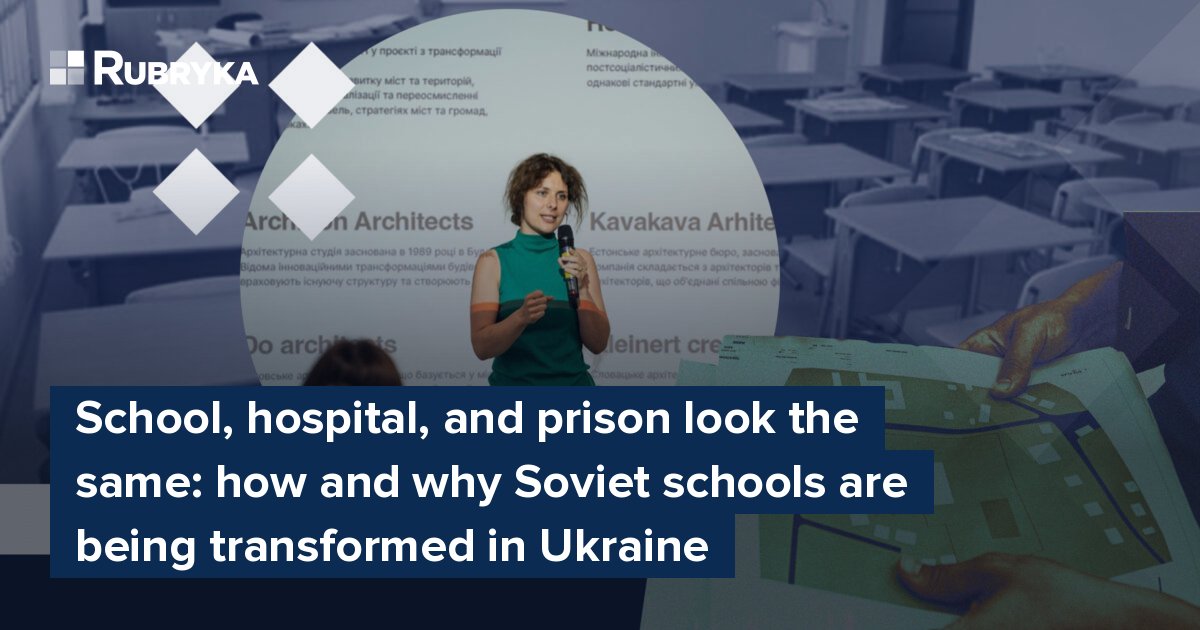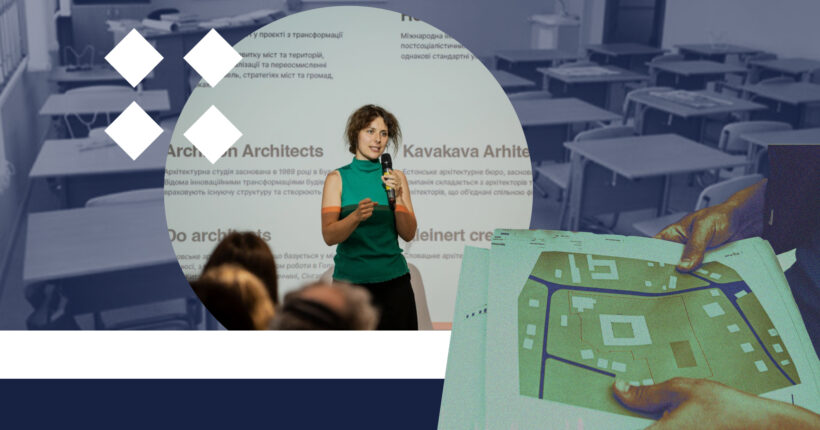
What is the problem?
Due to Russia's aggression, more than 180 schools were completely destroyed in Ukraine. "More than 300 educational institutions have been destroyed, more than 1,000 have been damaged and are subject to examination as to whether they can be rebuilt," informed Oksen Lisovyi, minister of education and science.
In the liberated territories of Kyiv, Zaporizhzhia, Kharkiv, Mykolaiv, Sumy, Kherson, and Chernihiv regions, 835 schools were damaged, and 745 are to be restored. Such data was provided by Viktoriya Titova, the CEO of the urban bureau Big City Lab, during an architectural workshop on the creation of a concept for the transformation of typical Soviet-style schools.
What is the solution?
The Ministry of Education and Science of Ukraine (MES), in cooperation with the NGO Mariupol Reborn and Big City Lab on the Minister of Digital Transformation Mykhailo Fedorov initiative, is creating a concept of architectural transformation of schools.
The Ministry of Education implements the actual development of the projects in cooperation with the executive partner Big City Lab and the architectural association Rebuild the Wonderful.
Rebuild the Wonderful is an initiative of European architects who have experience in successfully transforming old Soviet educational institutions in their countries, particularly Lithuania, Slovakia, and Estonia.

Plan of the territory of the school included in the pilot project.
The first step of this cooperation was a Kyiv-held architectural workshop on creating a concept for transforming typical Soviet schools.
What is the purpose of this solution?
To form a new philosophy of the educational space
Fedorov emphasized that this initiative is part of the comprehensive development of the transformation of education in Ukraine: "We must distance ourselves from the Soviet Union not only in the programs but also in the design of our educational institutions. Where we are, what we look at, and who we cross paths with also depends on our thoughts and inner content. The conceptual vision of the new education system must be reflected in the space: in the walls, halls, desks, and chairs so that it is all an interconnected system. For us, space is meaning."
He appealed to the participants of the initiative to rely in their development on the concept of the New Ukrainian School, the values and competencies that it lays down: "This is very important. We want the space to help our students master these competencies."
Minister of Education and Science of Ukraine Oksen Lisovyi notes: "Transforming our schools is a task of national importance. We must remove the metastases of the Soviet Union from our public culture."
According to him, democratic, Euro-Atlantic Ukraine needs completely different schools and kindergartens filled with different meanings. This space should be transparent, friendly, and barrier-free in the broadest sense.
Lisovyi draws attention to the fact that Soviet schools were built rather technologically. These typical projects aimed to form standard people who were cogs in the big totalitarian machine.
He also recalled the Ukrainian initiative to create typical schools by the architect Opanas Slastion at the end of the 19th century. All the schools he built were of the same type, but at the same time, each one was unique. Unfortunately, the Bolshevik coup of 1917 and subsequent events did not allow this project to develop. "Today, we are at the revival stage, and I am convinced that we are capable, as then, of doing something new and unique," says Lisovyi.
Today, Ukrainians face two challenges: to rebuild destroyed schools and to form a new network. According to Lisovyi, it is worth starting with developing a new philosophy of space. The team of architects who participated in the workshop would have a chance to participate in creative work and the transformation of Ukrainian society.
Viktoriia Titova, the CEO of the urban bureau Big City Lab showed the principle of Soviet-era buildings in one photo: a school, a hospital, and a prison look almost the same.

A fragment of the presentation of the project of transformation of educational spaces in Ukraine. Author's photo
"There was no question of what specific function this or that building performs — the approach worked: we build typically, quickly, standardly, because it's so convenient," says Titova.
How does it work?
Five typical Soviet projects were singled out
The idea arose during the work on the Mariupol Reborn project, says Titova: "When we came to the issue of education in the city, we put all the schools on the map and saw that they look very similar."
It turned out that 72% of all schools in Mariupol are the same five types. So Big City Lab concluded that five very good transformation projects should be done, providing the city with school projects for decades to come.
Next, the Urban Bureau, with the help of the Ministry of Education and the Ministry of Reconstruction, collected statistics on Ukraine and the seven regions that were occupied during the full-scale invasion: Kyiv, Zaporizhzhia, Kharkiv, Mykolaiv, Sumy, Kherson, and Chernihiv.
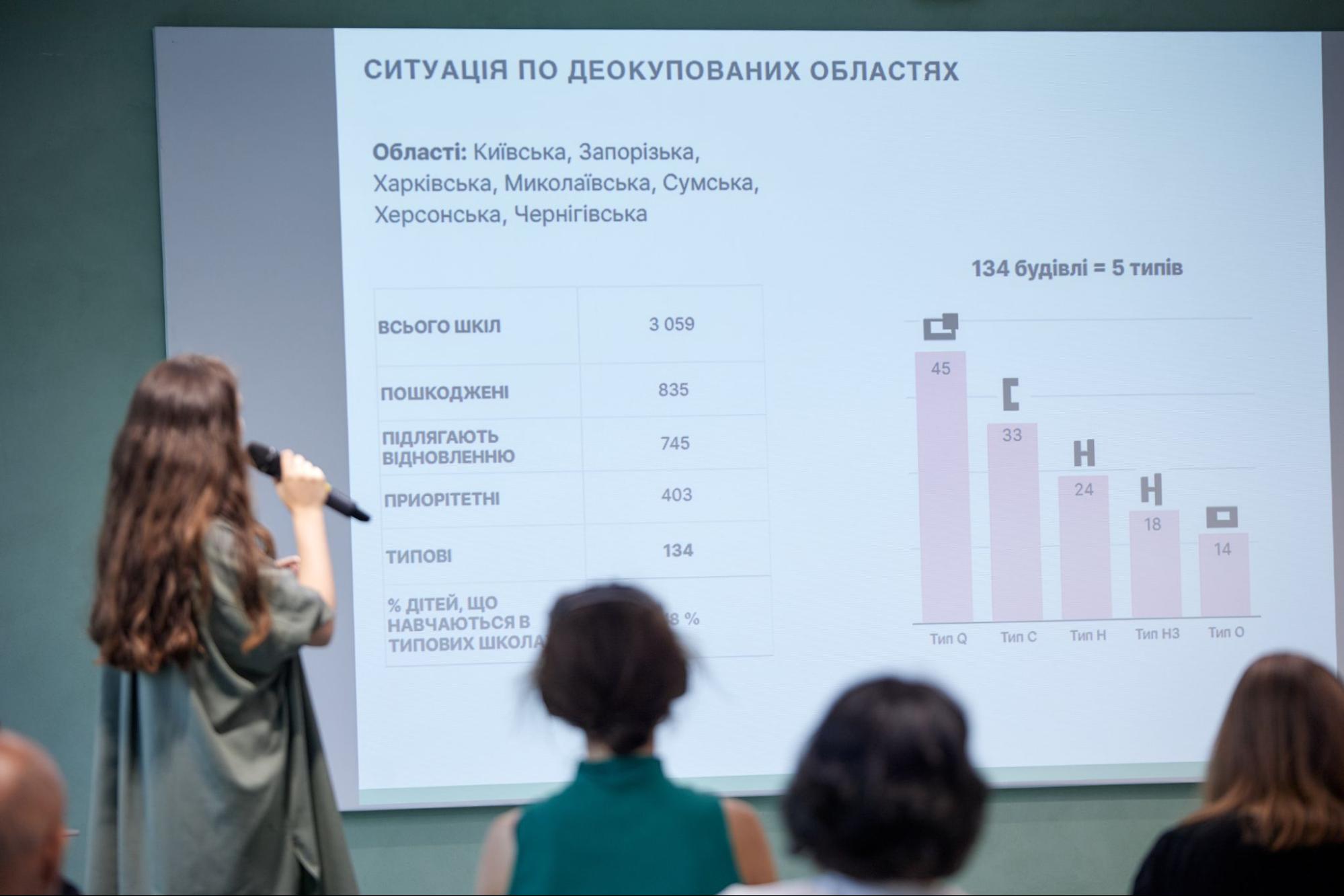
Titova presents the project of transformation of educational spaces in Ukraine. Photo by Artem Galkin
Of the 745 damaged schools to be rebuilt in these areas, 403 are identified as a priority in the educational network. Of these, 134 buildings were built according to the five typical Soviet projects mentioned above. 48% of students in these regions study in these typical buildings because most of these schools are large.
"The task of this particular project is to transform typical Soviet projects. They are already there, so we cannot demolish them and build new ones because it is neither ecologically nor economically impossible. We work with what we have, but when we talk about reconstruction, we do not mean to repair the ceiling and insulate the building but to transform it based on people-centeredness and barrier-freeness so that it meets modern needs in terms of its functionality," Titova shared with Rubryka.
Eight principles of building renewal
Soviet schools will be transformed into modern ones according to the following principles:
- mandatory availability of shelter;
- multifunctionality;
- a place for the community: the school should also work as a meeting place, co-working space, etc.;
- barrier-freeness;
- sustainable approach;
- common spaces should become areas of interaction;
- the school yard should become a safe space for recreation and learning;
- modern design using natural materials and calm colors.

Titova says a study by Big City Lab showed that children spend six and a half hours in the classroom for seven to eight hours at school. They do not go out even for a break because they often have nothing to do in the halls. And this must be changed.
Who and how will build a new concept
European architects in cooperation with Ukrainian educators
The pilot project team includes the international initiative of architects, Rebuild the Wonderful, which specializes in transforming post-socialist spaces.
These are architectural teams that have already made such transformations in their countries: Archicon (Hungary), Kavakava (Estonia), and Do Architects (Lithuania).
Co-founder and chief architect of Do Architects (Lithuania) and founder of Rebuild the Wonderful Gilma Teodora Gilite asked the participants and visitors of the presentation to answer the question: who went to the Soviet kindergarten? Who went to a Soviet school? Many people raised their hands. This simple technique demonstrated the commonality of the traumatic experiences in these countries; thus, the prescriptions for overcoming them might be similar.

Gilma Teodora Gylyte shows a Soviet kindergarten where children cannot see what is happening in the kitchen but want to, so they peek. In the third photo, thanks to a successful transformation, this space becomes open to children.
At the same time, the specialist emphasized that the Ukrainian transformation project could become an example for post-Soviet space:
"The Soviet empire used everyday architecture for propaganda and control over people, and unfortunately, we continue to use these structures. Eastern European countries have been independent for over 30 years. Yet, we still prioritize reconstructing schools based on Soviet values instead of transforming them into buildings that promote connections between people. Recognizing this mistake, Ukraine has the potential to change its priorities and transform its education system faster than we do."

Gilma Teodora Gylyte presents the project team. Photo by Big City Lab, Artem Galkin.
During the workshop, the co-founder and chief architect of Archicon, Nagy Csaba, the founder of Kavakava, Siril Valner, the CEO of Kleinert, Oliver Kleinert, and the partner of Do Architects, Vadym Babii, presented the already implemented projects for the transformation of Soviet architecture. To generate practical ideas, each of them went to a school of one of the five types and worked on developing the concept within a team alongside representatives of these educational institutions.
How were the pilot schools chosen?
The degree of building damage and the motivation of the directors
First and foremost, they were chosen from the damaged school registry to rebuild and transform the educational institution, explained Deputy Prime Minister Fedorov. He also noted that an important factor was the motivation of the local authorities, the director, and the school staff to participate in this process, as it would temporarily create certain inconveniences for the participants in the educational process.

Five typical schools that are part of the pilot project.
For safety reasons, the project initiators do not disclose the specific schools participating in the pilot project.
Rubryka visited a school with Gilma Gylyte and other project participants to get acquainted with the school being reconstructed as part of the project.
How the project will be implemented in a specific school
There were no direct strikes but the windows shattered
A tour for Gilma Gylyte, other project representatives, and the media is conducted by the head of the local community, the head of the community's education department, and the school principal herself.

The head of the educational institution begins the tour for the project participants and the media.
"This locality did not experience occupation, but it was subject to Russian shelling. In the community as a whole, 1450 objects were damaged," the village head recounted. "The school itself did not suffer direct strikes but incurred damage from artillery shell blasts: windows and doors were blown out, most of which have already been replaced in the facility. A minor impact also damaged the brickwork in the room housing the primary school's sports hall. This damage has not yet been repaired."

Damage from the impact of enemy projectile fragments.
According to regulatory documents, the educational institution has a shelter that is considered anti-radiation. However, due to its actual condition, it was classified as one of the simplest. The community authorities have developed an improvement project to meet the requirements for an anti-radiation shelter.

The shelter in the school has several rooms and can accommodate a total of 800 people.
The typical building constructed in 1978 currently has around 800 pupils. Compared to 2022, their number has increased by 40 children due to resettlement. This number of children is the absolute maximum for this space. There are 32 classrooms here, each accommodating between 20 and 30 children. There is one teacher's room with six tables for 54 educators.
However, the problem is not only the overcrowding.
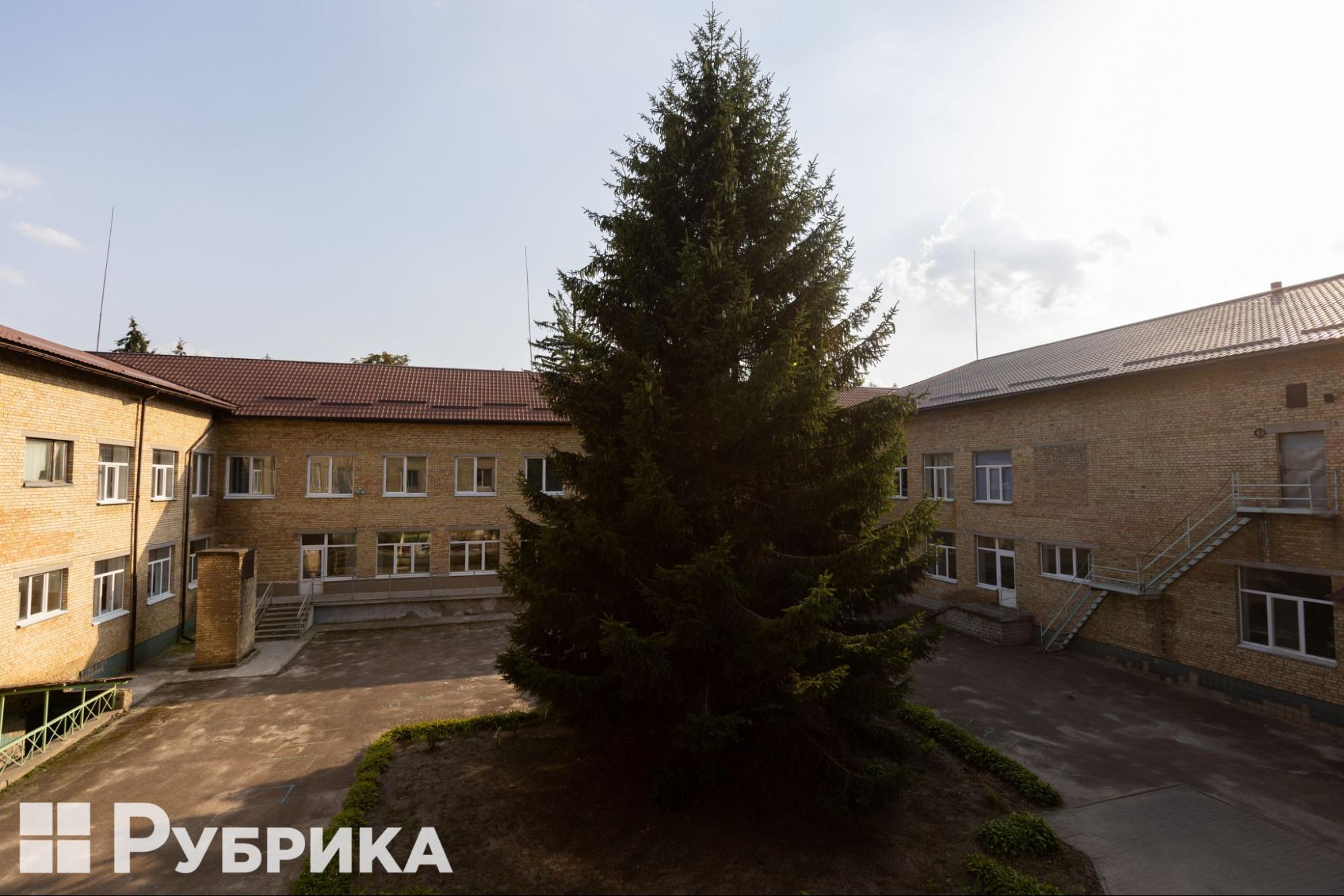
The school's inner yard serves as a space for small gatherings.
"The biggest inconvenience lies in the fact that the education system is changing. The methodological and educational work is being reformed, but the equipment and educational space remain old. We tried to update them, but it's not what the times demand," the local education department acknowledged. "The times call for modern laboratories, modern methodological rooms. After all, a classroom is not just a small corner; under such conditions, a teacher cannot fully realize their potential. These should be modern spaces for both educators and students, for educational and extracurricular activities."

The director of the institution is in one of the classrooms.

A brightly decorated biology classroom.
Searching for solutions for the maze
The head of the educational institution willingly opens all the classrooms and shows the problems inherent in the project and those that arose during the renovations. For example, the children's changing rooms near the gym became a room for technical equipment and a toilet, and students now change directly in their classrooms.

Announcement on the door to one of the sports halls in the school.

Gilma Teodora Gylyte takes a photograph of the school's sports hall.
The loud yet melancholic laughter of all the visitors was prompted by the doors to the storage room of one of the classrooms, which could boldly be called a weight-loss solution.

One of the project team members, Max Yakover, tries out the "weight loss doors."
A corridor on the second floor painted in a Barbie color became very trendy but hardly comfortable for prolonged contemplation.

The school is completing the renovation of the Barbie-colored corridor with its own funds.

Architect's reaction to the trendy color of the corridor.
At the same time, there are spaces and corridors in the institution that are not utilized at all. "We have a lot of free space that is not used at all. It is very difficult to do it on our own. There are no areas for relaxation, no areas for communication. As they say, most of the time children spend in classrooms; there is no place where we can invite parents to communicate," lists the school's principal.

The sideyard of the school is one of the unused spaces.
Gylyte examines all the premises, checking with the building scheme. She periodically makes marks, and from time to time, the word labyrinth comes out to both her and her partner. The school's corridors really remind of it. It is unlikely that we would have been able to find a way out of the building without the guidance of the headmistress the first time.

An overview of the biology classroom, with Gilma Teodora Gylyte in the foreground.
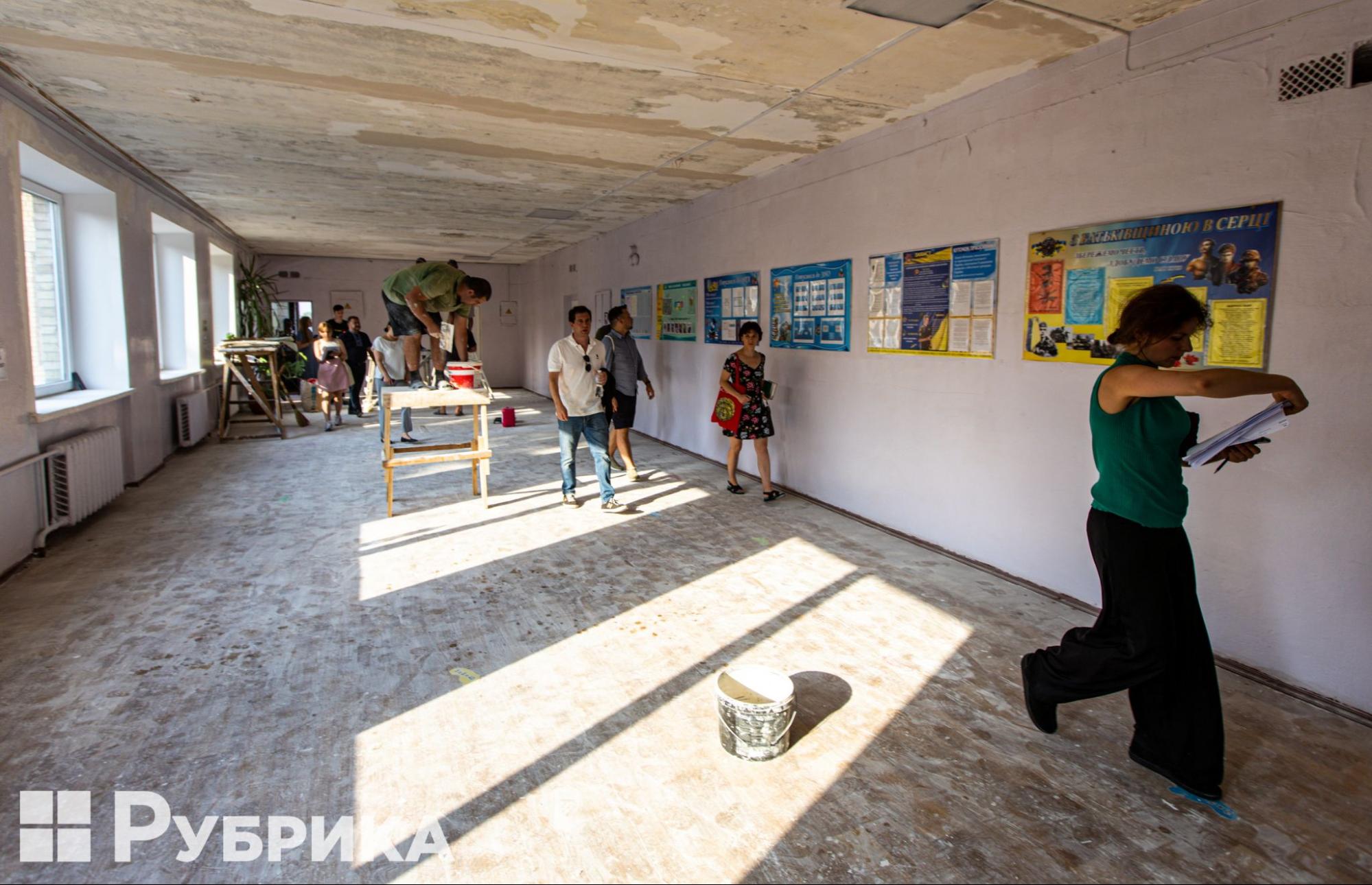
The inspection of the school premises is taking place simultaneously with the school renovation.
Some rooms on the first floor can only be accessed by descending from the second floor, particularly the library. The school aims to transform it into a digital library space.
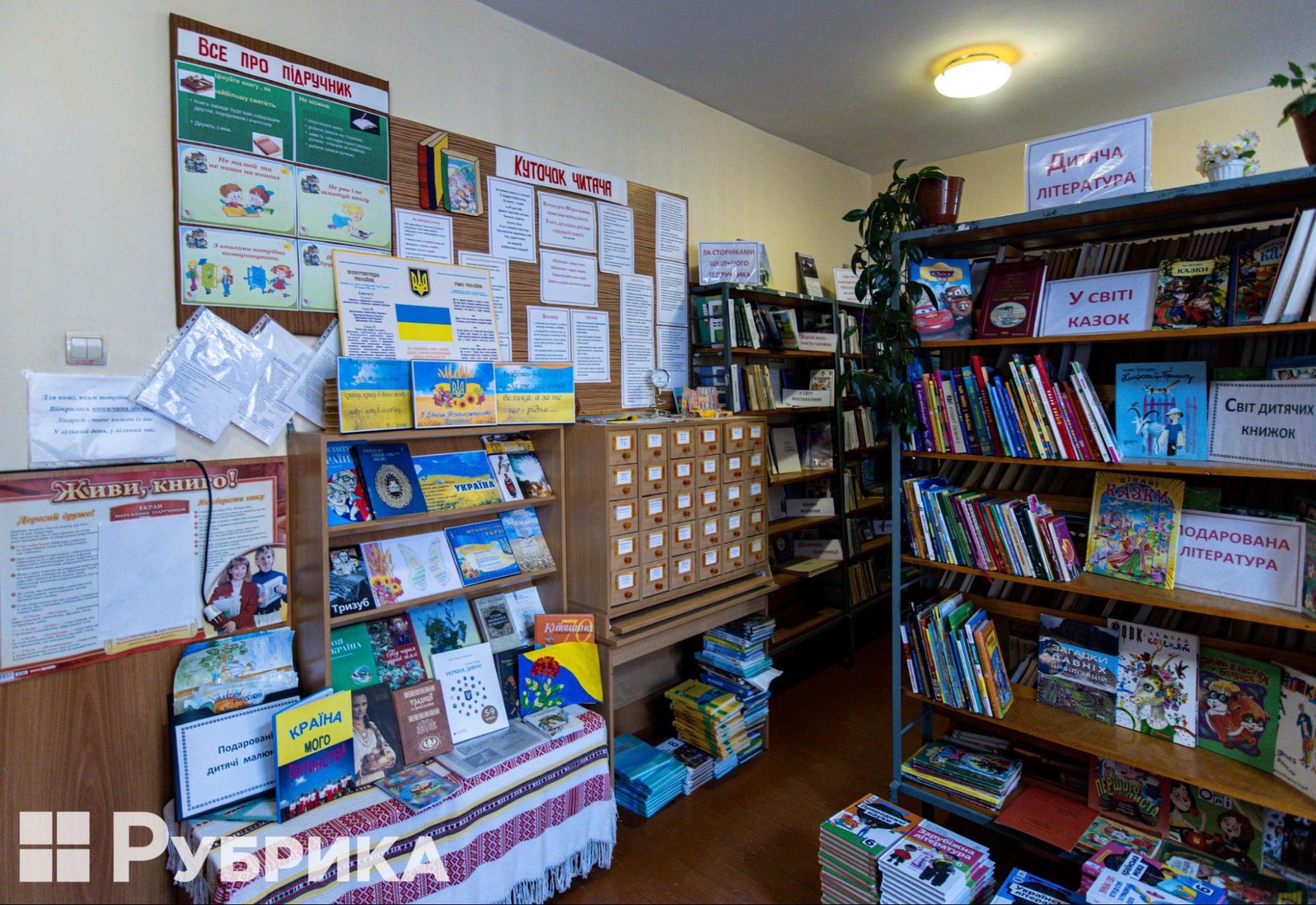
The school library. The institution aims to transform it into a modern digital center.
One of the solutions proposed by the architects at this stage is to encircle the space on both the first and second floors. It will be much easier to do it on the second floor, says the community leader, but finding a solution for this space on the first floor is still being sought as the technological room of the kitchen enters this space.
The school has a basic Soviet kitchen that serves around 400 children, 280 of whom are primary school pupils. The school cannot offer meals to all 800 students due to the small size of the dining room. At the same time, there is a partition in it that, according to the school's director, can be removed to free up some space for the serving line.
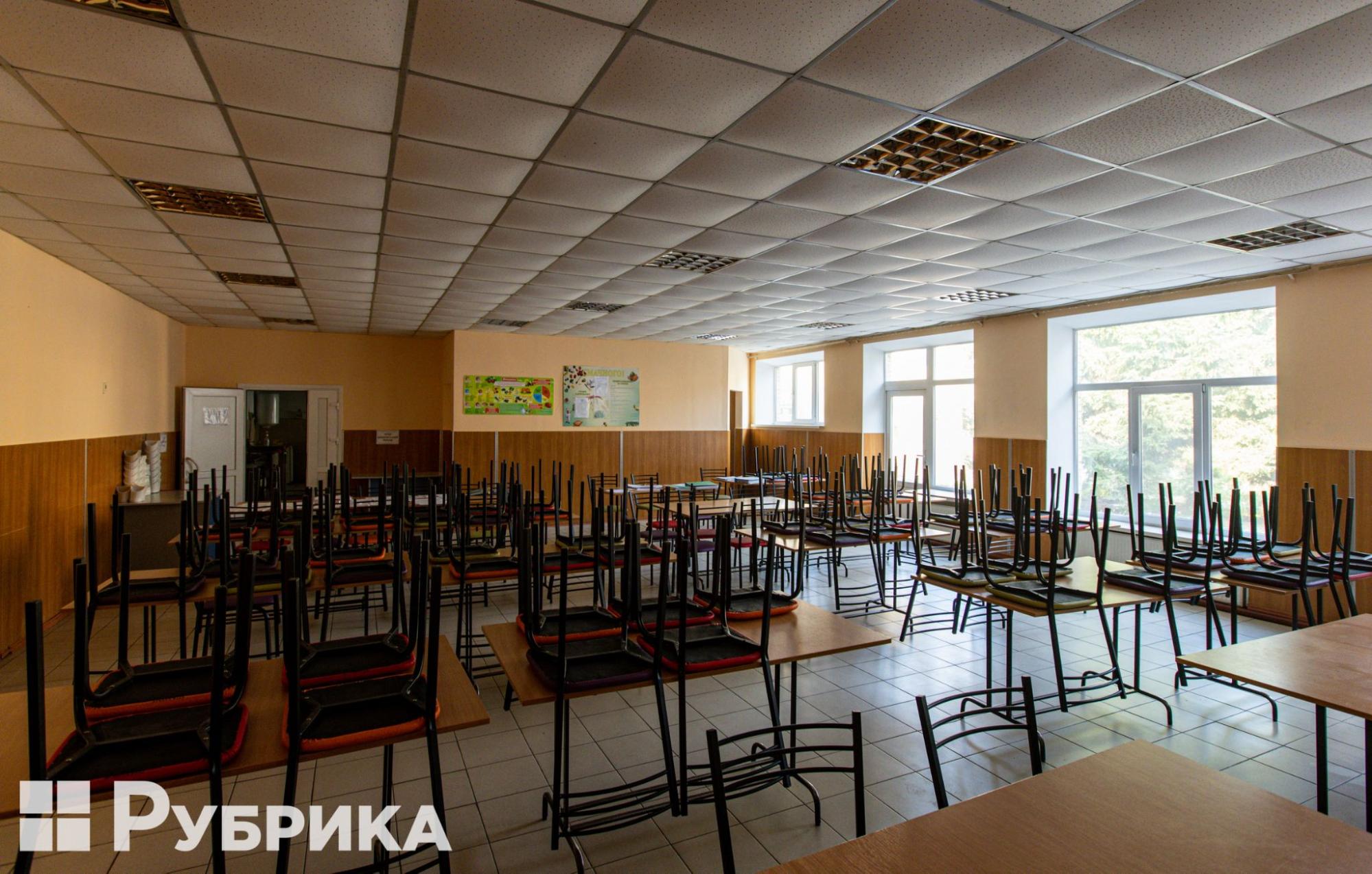
The dining room cannot physically accommodate a large number of students.
The over-hour-long inspection of the premises and active dialogue concludes with an agreement between the architect, Gilma Gylyte, and the school director to contact each other in the coming days for a deeper immersion into the problematic aspects of the institution and the search for common solutions.
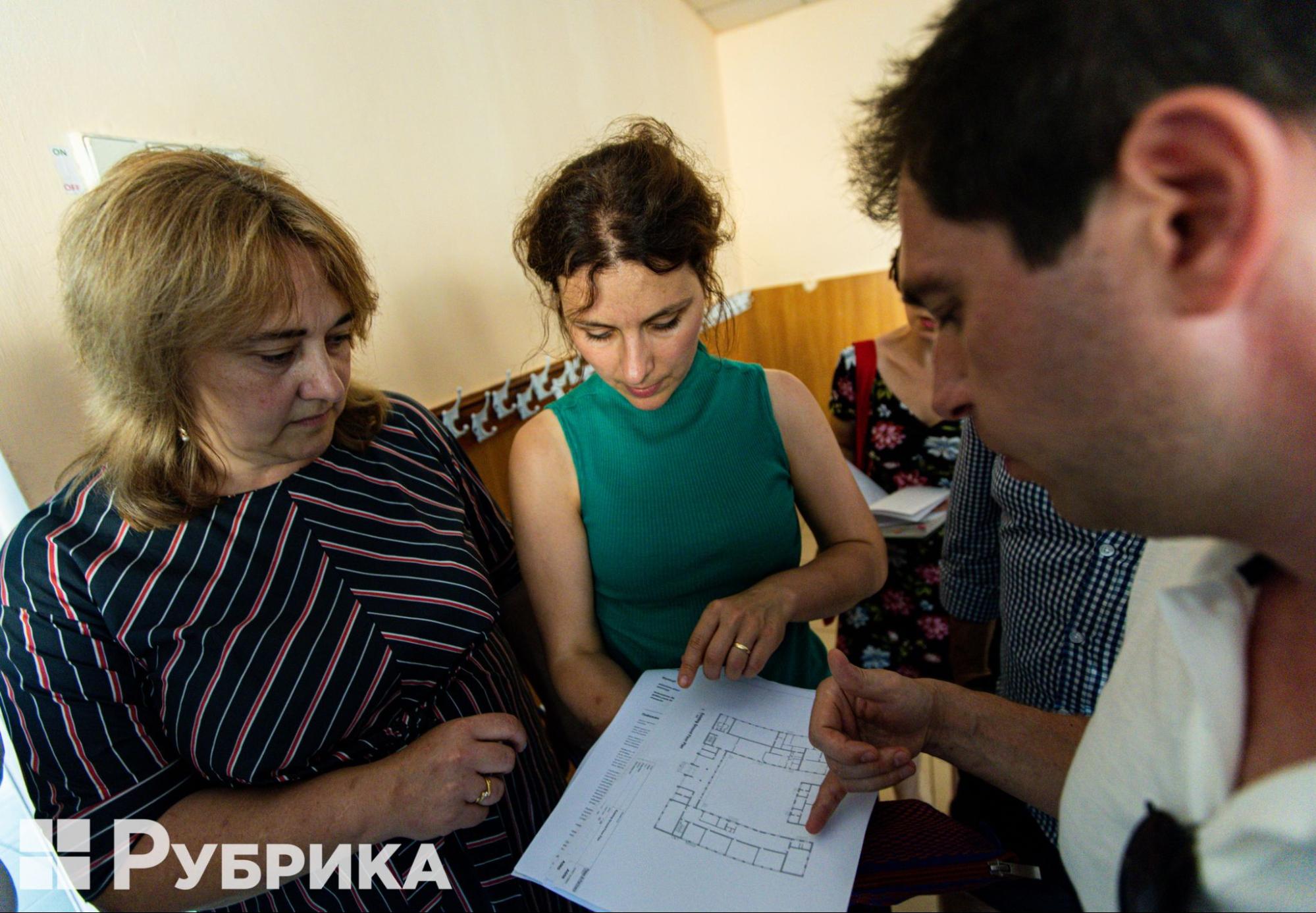
Discussion of the team's proposals together with the school principal.
Heat and fatigue do not interfere with understanding, although the conversation occurs in Ukrainian, English, and sometimes even Lithuanian languages.
What will come out of it?
How long will this project take?
The workshop participants are developing concepts for five typical Soviet schools. After refinement, the finalized concepts will be handed over to the Ministry of Education.
These pre-project proposals will be put up for public discussion, and if approved, the implementation of the solutions will begin, explained the Minister of Education and Science Lisovyi. Each pilot school will be reconstructed according to the proposed architect's solutions.

The head of the local community and the architect, Gilma Gylyte, are discussing possible options for using the school's interior space.
Moreover, in the event of success, these developments will be scaled across Ukraine for typical schools.

The school's sports grounds are always open to all community residents.
According to the minister of education, the implementation of the pilot projects is preliminarily planned for a year.
Other solutions
Typical projects from the Ministry of Reconstruction
In early August, the Ministry of Reconstruction announced the completion of the development of projects for the redesign of reuse. Local self-government bodies will be able to use standard projects to construct Administrative Service Centers, kindergartens, and schools of various sizes free of charge.
"Using standard projects will save costs and time for developing design documentation for reconstruction objects. They consider modern requirements for safety, accessibility, and energy efficiency. Moreover, they can be easily adapted to the needs of a particular community, thus accelerating the construction process to the maximum," noted Oleksandr Kubrakov, Deputy Prime Minister for Restoration of Ukraine, Minister for Communities, Territories and Infrastructure Development of Ukraine.
Minister of Digital Transformation Fedorov, in a comment to Rubryka, noted regarding this project: "We have had several meetings with the head of the Reconstruction Agency, looked at the projects and developments they already have, and provided feedback. Now, this will be a joint track for educational spaces. They just started first, and we caught up."
Meanwhile, using standard projects to construct new buildings has sparked criticism from the Ukrainian architectural community. For example, Anna Kyryi, Deputy Head of the Architectural Chamber of the National Union of Architects of Ukraine, asserts: "A standard project is a story where people are not considered. Neither their dignity nor their needs for comfort and aesthetics of the living space. The state said, 'We need it fast, and that's it.' It's the same paternalistic approach that smells of the Soviet era."
It turns out that, on the one hand, the state is trying to fill old Soviet boxes with new meanings, which are not profitable to demolish, and on the other hand, it proposes to build standard buildings. It is unlikely to be an easy solution.


